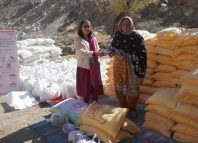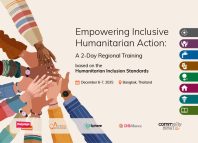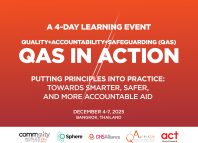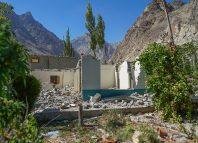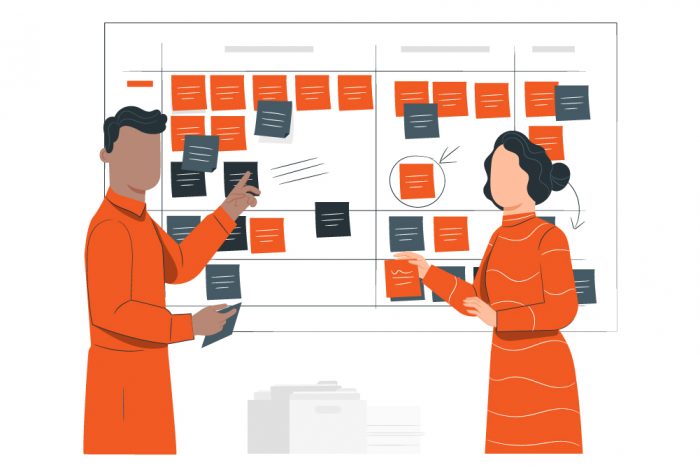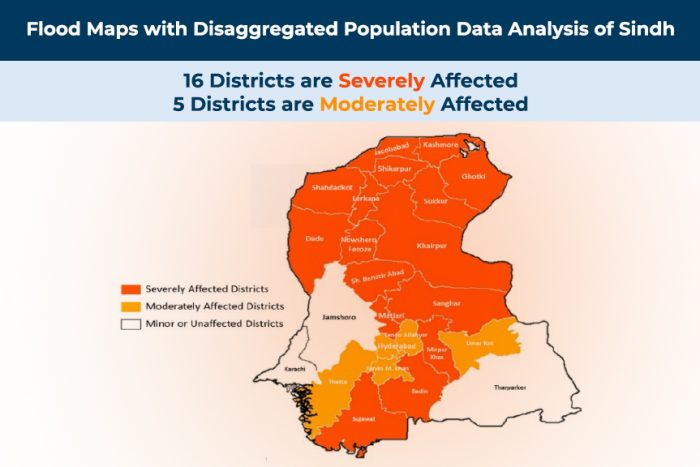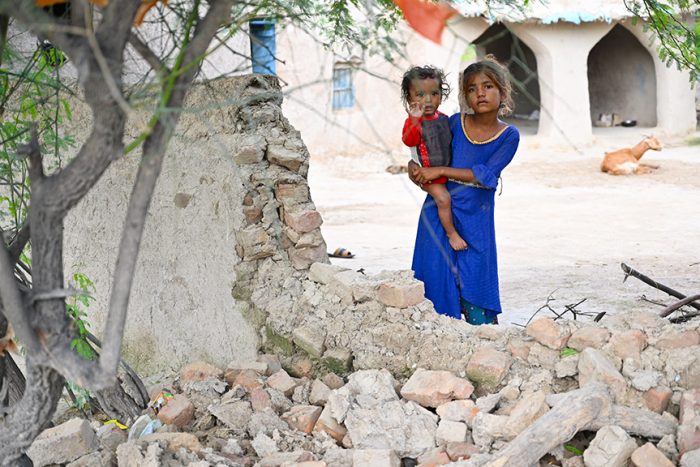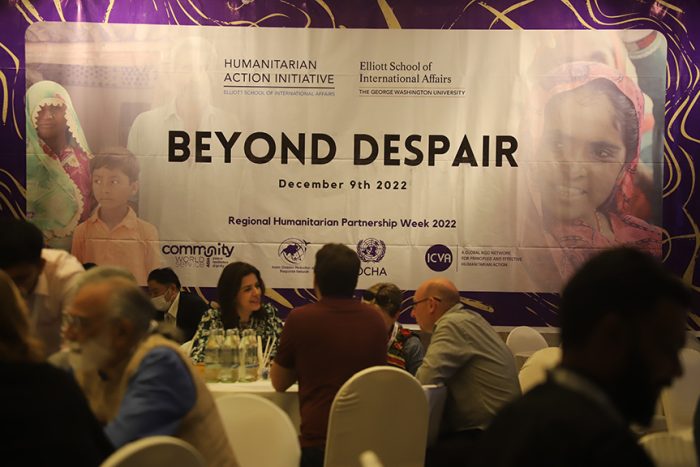comms
Integrating safeguarding to ensure quality and accountability in Flood Response
It is an essential responsibility of development and humanitarian organizations to ensure that the communities we work with feel safe. Safeguarding is a key pillar of any accountability mechanism and its incorporation in organizational policies, procedures and norms is paramount.
In light of the flood response in Pakistan, Community World Service Asia has launched a coaching and mentoring series on Safeguarding. This series, initiated in October 2022 and ending in January 2023, is led by Ester Dross, who has over 25 years of specializing in accountability, prevention of sexual exploitation and abuse, gender and child protection.
Through this platform, an estimate of 25 local emergency response organisations are mentored on how to address difficulties and concerns connected to maintaining and adopting Safeguarding standards, tools, and practices throughout the humanitarian program cycle.
Session 1- Safeguarding: From Theory to Practice
The first session, held on 26th October 2022, discussed the concept of Safeguarding and its distinction from protection. Ester also elaborated on the limitations and organisational responsibilities towards mainstreaming safeguarding in humanitarian action.
“It is important to discuss how we can move from theory to practice such that safeguarding policies are actionable, practical, widely applicable and well-known to staff as well as community members. Safeguarding entails that organisations have policies and procedures in place, from a Code of Conduct and safe reporting mechanism to recruitment procedures as well as appropriate disciplinary follow-up,” shared Ester.
Organizations can use international conventions and national legislations as the minimum benchmark in developing safeguarding policies but their norms should never be lower than legal norms. To ensure a strong safeguarding mechanism, organisations ought to have policies and procedures in place, from a Code of Conduct to a safe reporting mechanism, investigation systems and recruitment/vetting procedures as well as appropriate disciplinary follow-up in case of substantiated breaches.
Session 2- Integrating Safeguarding in Policies and Structures
The second session focused on how safeguarding can be incorporated in organizational policies and structures such as in human resource management and project design in a contextualised manner while also establishing strong support networks for safeguarding incidents.
“Contextualising safeguarding policies and procedures is not a one-fits-all approach. It could be subject to country, region and even project. While some elements should be contextualised including the program cycle, project design, logistics CRM channels and job descriptions, some elements are universal and thus applicable everywhere such as PSEA Rules and minimum standards,” said Ester Dross, in the second session on November 15.
“Aspects of safeguarding can be integrated in an organisation’s HR systems, security clearance and capacity building activities. Humanitarians have to be oriented on why safeguarding structures, policies and systems are vital to exist in any workplace,” shared a participant.
Session 3: Establishing an Effective Complaints Response Mechanism
Marking halfway through the series, the third session on 24th November 2022 focused on how an organization can establish or adopt a complaints response mechanism especially for an emergency situation within its accountability framework.
“As one of the fundamental pillars of ensuring safeguarding, a robust CRM is marked by four key elements- accessibility, transparency, confidentiality, and safety & security. It is ultimately about giving power to the people throughout the process- not only receiving complaints but also addressing and resolving them,” said Ester Dross.
Through breakout room and large group discussions, participants also brainstormed what an emergency set up of an effective CRM should incorporate. The session emphasized on including safeguarding policies in vendor contracts, displaying safeguarding and CRM messages in local languages. Ester stressed on establishing a robust follow-up mechanism and enforce a zero-tolerance policy on sexual abuse and other forms of exploitation. Ester added, “It is essential to adopt timeliness, and set up accessible reporting methods. Along with being trained to handle complaints effectively, staff needs to be clear on their roles and responsibilities.”
Session 4: Setting up a Community Based Complaints Mechanism
Establishing a community-contextualised complaints system that enables local communities to exercise their right to make complaints is essential. An effective Complaints Response Mechanism (CRM) does not only constitute receiving complaints but also investigating them and communicating clearly about the process to communities and how to respond to it.
The fourth session, held on 6th December 2022, continued the discussion on developing an effective CRM (carried on from session 3). Participants examined the elements that organisations need to consider while communicating about CRM and safeguarding with their staff, external partners and communities. It emphasised on ensuring staff’s capacity building on safeguarding and CRM, having an agreement with partners on minimum standards of safeguarding to be followed and using local languages and terms when engaging with communities.
“Key messages related to safeguarding and CRM should be displayed at the workplace. It is always good to be reminded that one is working in a safe environment”, shared a participant in the virtual event.
Session 5: Accountability and Safeguarding
The fifth session, held on 20th December, focused on identifying various humanitarian networks and their role in safeguarding and explored specific links between accountability and Preventing Sexual Exploitation, Abuse and Harassment (PSEAH). A participant in the virtual session shared, “Networks to provide legal, medical, psychosocial, and safety support are a concrete example of moving from theory to practice in the context of safeguarding but this is not without its challenges. Organisations in Pakistan are hindered by a lack of connectivity and mapping in the context of safeguarding.”
In the breakout rooms and open plenary, participants discussed what organisations need to think of, evaluate, and set up in reference to commitments of the Core Humanitarian Standard to PSEAH.
Key Takeaways from the session
- Aid organisations must identify specific vulnerabilities of communities to safeguarding and ensure that additional risks are not created
- Staff must be oriented on how to respond to a sensitive issue or complaint – in terms of behaviour, language and messaging
- It is essential for staff to have cultural intelligence competency to respect and understand local norms
- Organisations must coordinate with other stakeholders (especially government and non-governmental) to ensure a complementary and effective response that places communities at the centre.
Session 6- The Finale – Safeguarding Investigations
The coaching and mentoring series on safeguarding was concluded on 10th January 2023 with the last session focusing on investigation procedures around sensitive complaints and corresponding responsibilities within an organisation.
Participants shared the principles of an investigation and gained clarity on the processes. Group discussions focused on distinguishing the key roles of each member in the investigation process; i,e., that of the focal point, investigation team, investigation manager, and senior management.
“While there are general guidelines on key roles and responsibilities in an investigative process, it is always an organisational decision on how to exactly formulate it. What is important is that the process places survivors at the centre, that it is fair, structured and professional following thorough analysis of all evidence,” shared Ester.
Participants’ Insights
1. “Participating in the safeguarding series was one of a kind experience. The quality of the content was excellent and the trainer presented it with great expertise. The interactive digital tools used during the series, including Jamboard, breakout rooms and quizzes was quite effective and engaging. Being able to relate theoretical concepts with practical examples, and getting the opportunity to discuss our own experiences and challenges made this learning series very useful and informative for me.”
Mazhar Hussain, READ Foundation
2. “The knowledge I received through the series helped me comprehend how to stop harm from happening before it occurs, how to acknowledge and handle complaints, and how to guarantee the complainant’s confidentially. The information obtained will help to educate people about our investigation procedures and to bring to light problems that endanger women and children. It will also assist us in creating a robust system to protect women and children.”
Samreen Najeeb, Protection & Human Rights Organisation (PHRO)
3. “The virtual coaching and mentoring series on Safeguarding training series was an overall good experience albeit a few connectivity issues. I found the series to be quite insightful as most of the topics were new to me especially CRM, difference between protection and roles and responsibilities of different stakeholders in ensuring safeguarding, and accountability. This training will be helpful to our organisation to build changes in our current safeguarding policy, staff training and field implementation.”
Noor-ul-Amin Keerio, SAFE Pakistan
Training On: Introduction to Core Humanitarian Standard | Quality and Accountability Mainstreaming
When: 13th-15th, February 2023 (arrival at venue on 12th-Feb-2023)
Where: Sukkur, Sindh
Language: Urdu and English
Interested Applicants: Click here to register
Last Date to Apply: 29th-Jan-2023 (incomplete applications will not be entertained)
Training Objectives: Through this training, you will be able to:
- Identify the key Quality & Accountability initiatives
- Select and adapt existing Quality & Accountability tools and resources
- Outline the opportunities and challenges faced by humanitarian workers in implementing Q&A approaches and tools
- Identify means by which you and your colleagues can collaborate and coordinate with other agencies to improve the quality and accountability of a humanitarian response
Training Purpose
Introducing and mainstreaming quality and accountability mechanisms through the organisation
The impact of humanitarian work on communities depends greatly upon the quality of services and accountability of actions both during emergency and non-emergency times. With millions of people affected by disasters and conflicts, the importance of Quality & Accountability (Q&A) is undeniable. The effective implementation of Core Humanitarian Standard on Quality and Accountability (CHS) requires a commitment to build institutional and individual capacity of people engaged in designing and implementing humanitarian as well as development projects.
Community World Service Asia (CWSA) aims to ensure that all relevant agencies including NGOs, INGOs, UN, donors, universities and government agencies, playing an active role in the disaster response & rehabilitation are given the opportunity to implement Quality and Accountability approaches and tools in their work.
Number of Participants
- 20-25 participants will be selected for the training. Women and staff belonging to ethnic/religious minorities are encouraged to apply.
- Preference will be given to participants representing organizations working in Sukkur and surroundings.
Selection Criteria
- You have experience in managing a key position (Programs, operations, MEAL etc.)
- You have an idea about the Q&A initiatives
- You are interested in introducing Q&A mechanisms in your organisation
- You have a ‘good enough’ command of English.
Fee Details
- Training fee for each participant is PKR 10,000. Fee concessions and scholarships are available for participants belonging to marginalised groups and NGOs with limited funding.
- No TA/DA will be given to participants and travel expenses will be incurred by participants themselves.
Community World Service Asia (CWSA) is a humanitarian and development organization, registered in Pakistan, headquartered in Karachi and implementing initiatives throughout Asia. CWSA is member of the Core Humanitarian Standard (CHS) Alliance, a member of Sphere and their regional partner in Asia and also manages the ADRRN Quality & Accountability Hub in Asia.
Prioritising Education whether in a crisis or not
After one of the worst floods in the nation’s history destroyed and damaged nearly 27,000 schools, more than 2 million students in Pakistan remain without schools and formal learning. Schools play a pivotal role in ensuring that children have access to emotional support, psycho-social health, and immunisation in addition to serving as places of learning.
Community World Service Asia in collaboration with School Education and Literacy Department (SELD) conducted Play Based Learning Sessions in Temporary Learning Centers (TLCs) with students affected by floods and rains. These sessions strengthened the process of building resilience by engaging children in play based learning as a possible coping mechanism post crisis and trauma.
Flood Recovery & Rehabilitation Strategy and Response in Pakistan: Assistance strategies for communities in crisis
Background:
The current monsoon spell that started in the second week of July 2022 has caused widespread flooding and has led to extensive human and infrastructure damage across many parts of Pakistan. The Government of Pakistan estimates that around 33 million people across the country are affected by the rains, floods and consequent impacts such as landslides. More than 421,000 refugees living in calamity-declared districts are also affected or at risk. As of August 2022, some 6.4 million people are estimated to need of assistance.[1]
According to the National Disaster Management Authority (NDMA)’ Monsoon Situation Report on August 30, 2022, around 1,057,388 houses were damaged (including 324,386 fully and 733,002 partially damaged). In addition to this, around 5063 KM roads have been washed away, 243 bridges have collapsed, and 730,483 animals have died.
Southern and central Pakistan have been most affected, particularly Balochistan and Sindh provinces. Balochistan has received 5.1 times its 30-year average rainfall as of 27 August, while Sindh’s is 5.7 times its 30-year average. b
Death and injury is extensive and likely higher because of unreported number in Balochistan, Khyber Pakhtunkhwa (KP), and Sindh provinces. In the same vein, livestock and agriculture was impacted threatening food security. In addition, the floods are expected to strain existing healthcare services as gastrointestinal illnesses, malaria, skin infections, snake bites and injuries are anticipated to increase significantly.
Current situation and implications for Pakistan, Sindh province
Sindh province is affected most adversely by heavy rainfall and resultant flooding in Pakistan. Over 110 districts have declared a state of emergency in Sindh province. According to the Provincial Disaster Management Authority of Sindh, over 240,000 people remain displaced in the province as of 3 December 2022. Nearly 90% of flood-displaced people are reportedly with host communities, while the remaining are in tent cities and relief camps. While receding flood waters have allowed millions of people to go home, there are reports of significant service gaps in areas of return, in addition to extensive impacts to homes, agriculture, and livelihoods. In general, access to clean food, water, clothing, shelter and the ability to find safe areas to rest and sleep has and continues to be a challenge.
Public health concerns are high due to damaged infrastructure, stagnating water and inadequate sanitation facilities. In Sindh, between July and early October, nearly 350,000 people were suspected of having malaria, more than 700,000 had some form of diarrhea, and over 770,000 people reported skin-related diseases. The practice of open defecation has increased from one-fifth before the floods to over one-third of the affected population, with 6 million no longer having home sanitation facilities.[2]
Women and girls are vulnerable to sexual exploitation and abuse because safeguarding measures are not designed into the programmes by the organisations. Protective mechanisms such as safe spaces and support services have either been destroyed or no longer exist. Moreover, women play a large role in the household, as such, access to clean water for cooking, cleaning and toileting no longer exist. Similarly, the services such as information provision, participation, and feedback are unavailable to them and other vulnerable groups resulting in being excluded from the participatory approach at all levels.
Overview of Damage in Sindh (according to Provincial Disaster Management Authority (PDMA) Sindh from June to Dec 2022)[3]:
- 8,422 people injured
- 801 deaths
- 436,435 Livestock Perished
- 642,672 houses partially Damaged, 1,415,677 houses fully damaged
- 3,777,272 acres of land damaged
- 12,356,860 people affected
- 194,562 people displaced
- 59 health facilities fully damaged and 461 partially damaged[4]
Geographical focus of CWSA: Sindh, Pakistan
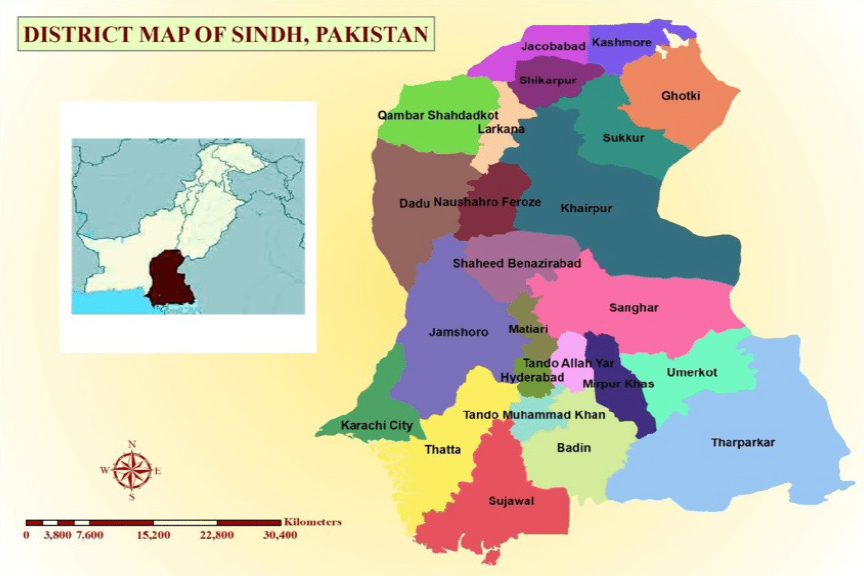
Recommended programming for recovery and rehabilitation in the following areas:
- Food/cash assistance – to reduce food consumption gaps and supporting populations as they restore livelihood and/or livestock.
- Reconstruction/rehabilitation of livestock and agriculture – replacement of lost livestock, rehabilitating surviving livestock, restoration of agricultural produce, reconstruction of animal shelters, re-establishing irrigation infrastructure and equipment as part of restoring livelihoods amongst impacted populations.
- Cash assistance/cash for food/cash for work – These efforts are targeted towards disaster risk reduction (DRR) in that strategies are implemented to prevent new disaster risks, reducing existing disaster and managing residual risks in order to strengthen resilience and reduction of disaster related losses.
- Shelter – with the view of mitigating gender-based violence, exploitation of children etc. as a consequence of displacement. Moreover, the provision and utilization of shelter packs that are procured using local materials to flood-proof homes as part of overall DRR strategies.
- Healthcare services – provision of essential medicines, menstrual hygiene products, and malarial treatment in an effort to support existing medical services. In addition, leveraging existing public health clinics and local government facilities that are in need of rehabilitation and improvement. Integrated Sexual Reproductive Health (SRH), clean delivery kits/newborn baby kits, capacity building of local health workers (LHWs, Marvi workers).
- Quality & accountability (Q&A) – To mainstream Q&A across humanitarian organizations and Accountability Learning Working Group (ALWG) organizations, systems, tools, procedures and standards and to undertake capacity building in Q&A and Safeguarding of staff. Also, to develop resources in local languages for dissemination on a wider scale.
- Education – De-watering, cleaning, and disinfection of schools to facilitate the resumption of educational activities in a safe and healthy learning environment, distribution of educational teaching and learning materials, training teachers on psychosocial support, multi-grade teaching and teaching in emergencies, training and mobilization of School Management Committee (SMC) members on psychosocial support, safe school reopening, and functioning of schools. Programs to build teacher’s capacity on the learning environment, teachers’ trainings on positive learning environment (PLE), teachers training on early childhood care and education (ECCE) and play based learning activities.
[1] https://reliefweb.int/report/pakistan/pakistan-2022-floods-response-plan-01-sep-2022-28-feb-2023-issued-30-aug-2022
[2] https://reliefweb.int/report/philippines/asia-and-pacific-weekly-regional-humanitarian-snapshot-25-31-october-2022
[3] https://reliefweb.int/report/pakistan/provincial-disaster-management-authority-pdma-sindh-daily-situation-report-december-14-2022
[4] https://reliefweb.int/report/philippines/asia-and-pacific-weekly-regional-humanitarian-snapshot-25-31-october-2022
Kasturi; the Man of her Family
In 2021, the drought killed their three-acre crop and with it their hopes for food on their plates. But Kasturi and her husband Khamiso, who is diagnosed with acute asthma, considered the family fortunate to be project participants of Community World Service Asia (CWSA), PWS&D & CBGB’s[1] food aid programme starting in April and spread over six months. In September with her fractured arm still not fully healed she had not returned to her work as a midwife. Though at the rate of PKR 500 (Approx. USD 2.23) at most for a delivery and two to three cases per month, she was making very little, but even that was not to be sniffed at and she was keen to return to her work. Her orthopedic surgeon, however, told her she would not be able to resume work before February 2023.
With their son grazing a livestock owner’s twelve cows for PKR 400 per cow per month, the family at least had a steady income of PKR 4800. Living with the hope that the summer monsoon will not fail, the couple worked their three-acre spread and sowed it with guar, mung and millets in June 2022. After a long time, heaven was benevolent and they saw the seed sprout and grow as it had not been seen in years.
But when the rain did not stop for four straight days, their chaunras (Hut) began to collapse. So great was the rain and so excessive its weight on the thatch that half a dozen rafters simply cracked under the strain. As the downfall began, the August installment of ration aid came in the way and the family lost the entire supply of wheat flour. Kasturi, forever looking at the brighter side, said all was not lost for she fed the flour to her goats. As for the rice and lentils, that can easily be cleaned and used.
The last food aid was due a few weeks after this interaction and Kasturi was of the view that it would see them through to the time that the first of their millet will be in the grain silo. When their entire lot is harvested and their larder and silos filled, they will dispose of the rest against cash. As all desert dwellers know that the rafters are the major rebuilding expense and some of that income will go to providing the PKR 30,000 (Approx. USD 13.35) to make their homes habitable again. That is a good deal better than the drought. If the rains destroyed their shelters, at least they were enough to give them a harvest as they had not seen in many years.
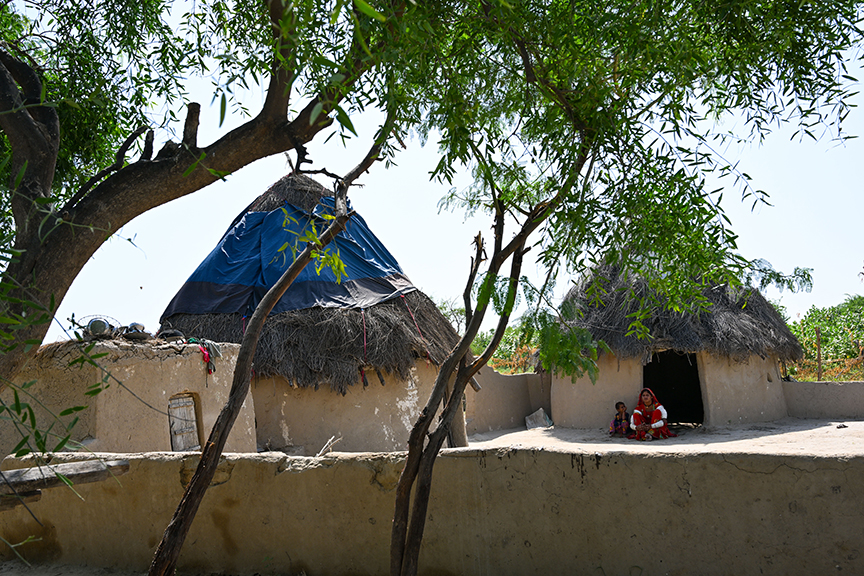
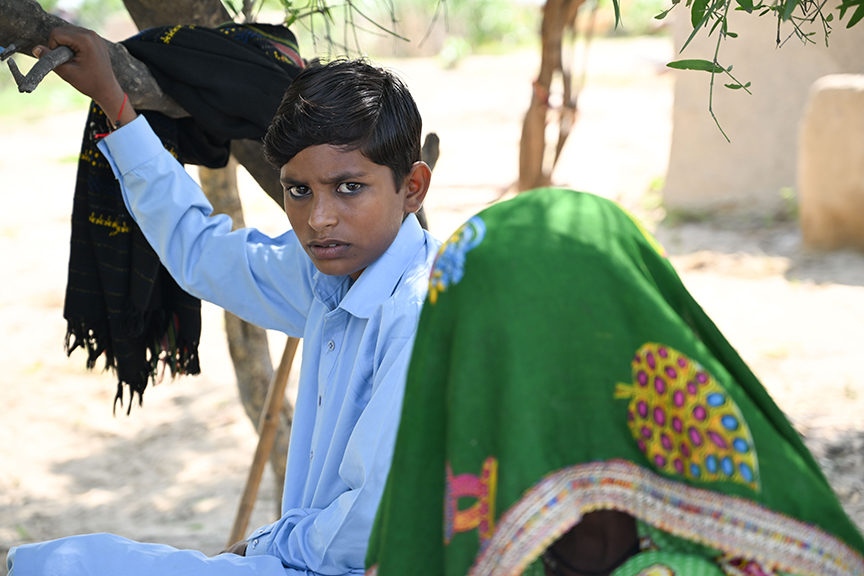
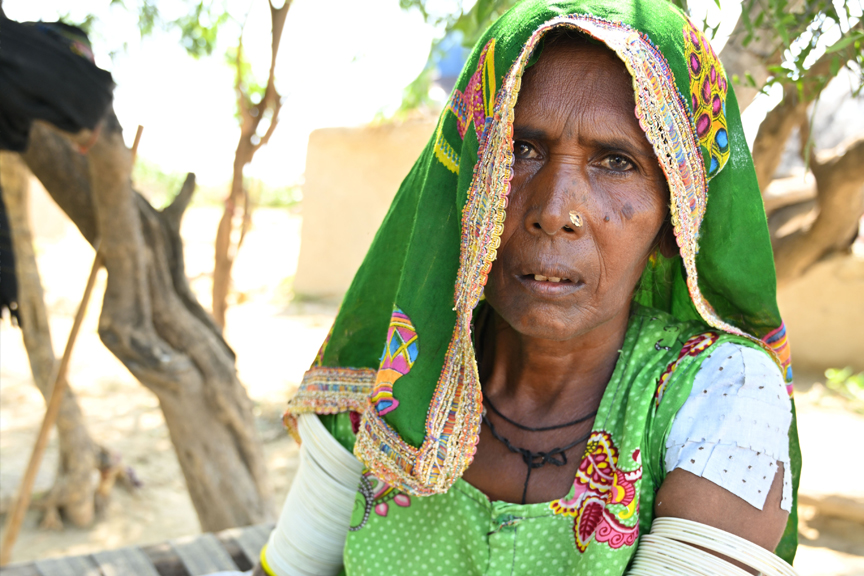
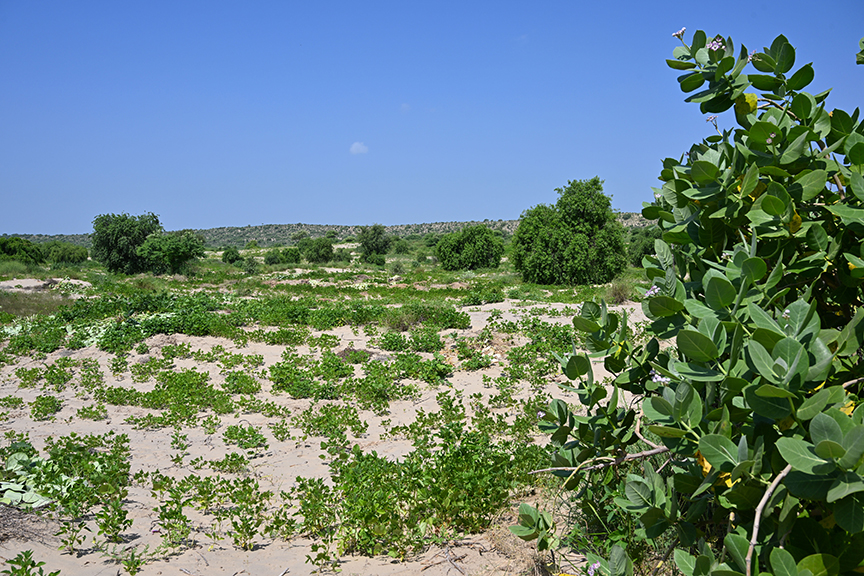
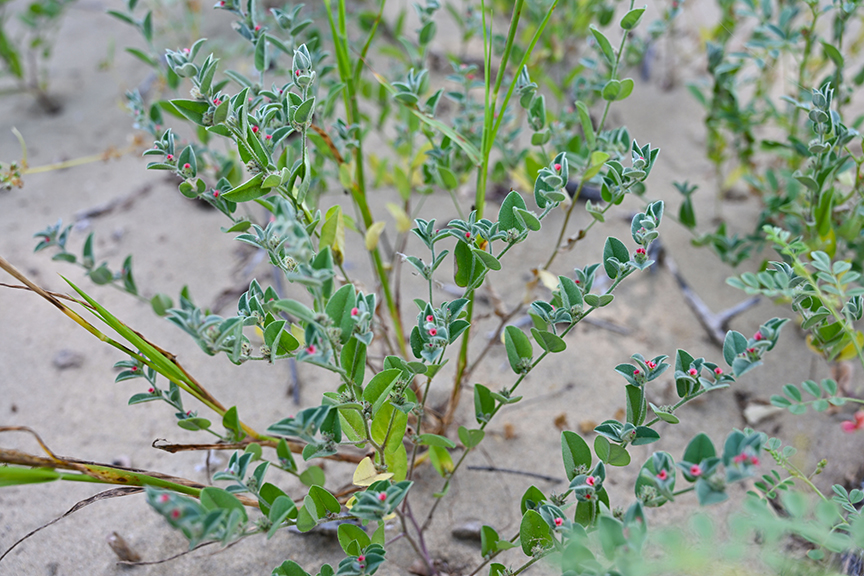
[1] Presbyterian World Service & Development & Canadian Foodgrains Bank
After the flood: still rebuilding amid uncertainty
Shehdev of village Veri Sal Sarety lying 6 kilometres southwest of Umerkot, the second youngest of seven brothers is a bachelor while all the others are wedded. One of them passed away some years ago leaving behind three little children. Then the widowed mother walked out of the home leaving her children in the care of their uncle. Shehdev thus cares for four souls that includes these three children and his mother. Herself illiterate, the mother is a remarkable women for she and her husband had worked hard to educate all her seven sons. No surprise then, that Shehdev is a matriculate.
Shehdev works as a bricklayer wherever he can get work. And this is mostly in Umerkot, 6 kilometres away. With the fare being PKR 60 (Approx. USD 0.27) out and back, his daily wage varying between PKR 800 and PKR 1000 (Approx. USD 3 and 4.45), is enough to put reasonable food on the table for the five-member family. To supplement this income, Shehdev’s mother goes to the flooded cotton fields to pick the ripe crop. She knew the flood has caused venomous snakes to take refuge among the vegetation, but the work cannot be given up, especially at a time when other work is hard to find.
In July, the deluge came and construction work came to a halt. Some little savings from his work helped Shehdev and his family make it through the first couple of weeks before things began to get difficult. Had there not been some work helping local landowners drain their flooded fields and for his mother to endanger her life in the cotton fields, Shehdev would have gone under debt.
In early September 2022, food was the least of Shehdev’s worries because his mother continued her work and brought some cash. He was more concerned with the rebuilding of his collapsed home. Sahehdev, now living under a makeshift tent on higher grounds nearby to escape the flood waters, admitted the cost would be negligible because the clay for the bricks was locally available and the rafters for the collapsed roof were undamaged. Being a bricklayer himself, he was better acquainted than most with the work and as soon as he got some cash, he would begin reconstruction. If only his two yearling bulls had not died during the rains, he could have easily disposed of them for a neat PKR 70,000 (Approx. USD 312) and raised his home in quick time. But without that ready cash gone, he has to rely for cash from his mother’s farm work and himself if he is called to help drain a field. Shehdex, who is now supported through one of Community World Service Asia’s development projects, will only be able to return to work as a bricklayer when construction begins again after the last crowds have dissipated.
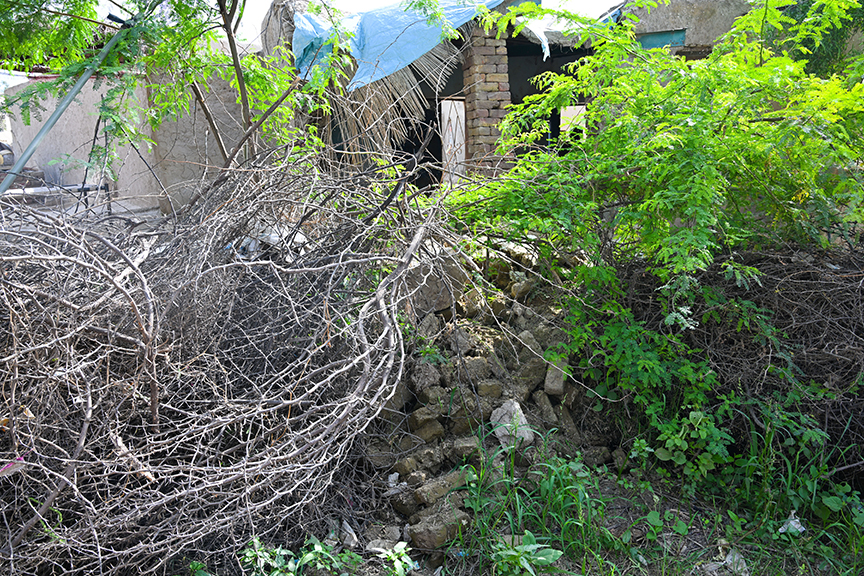
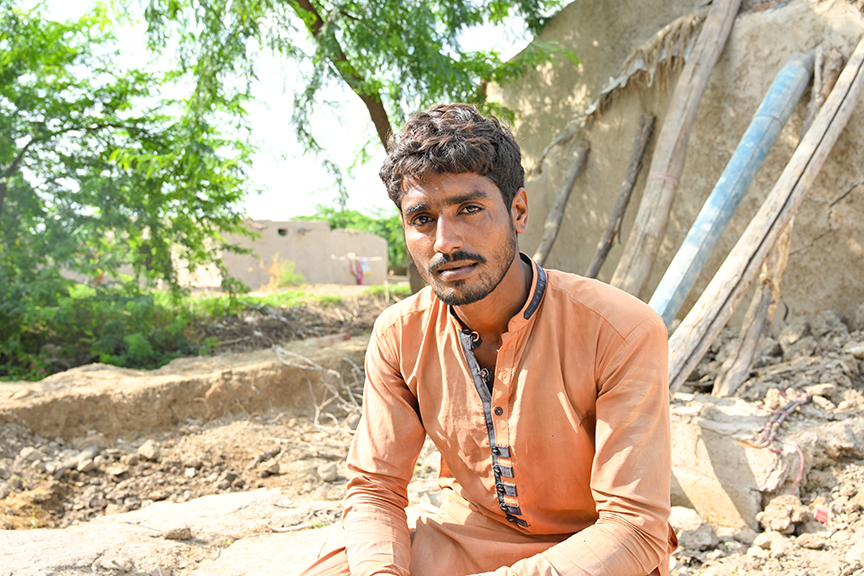
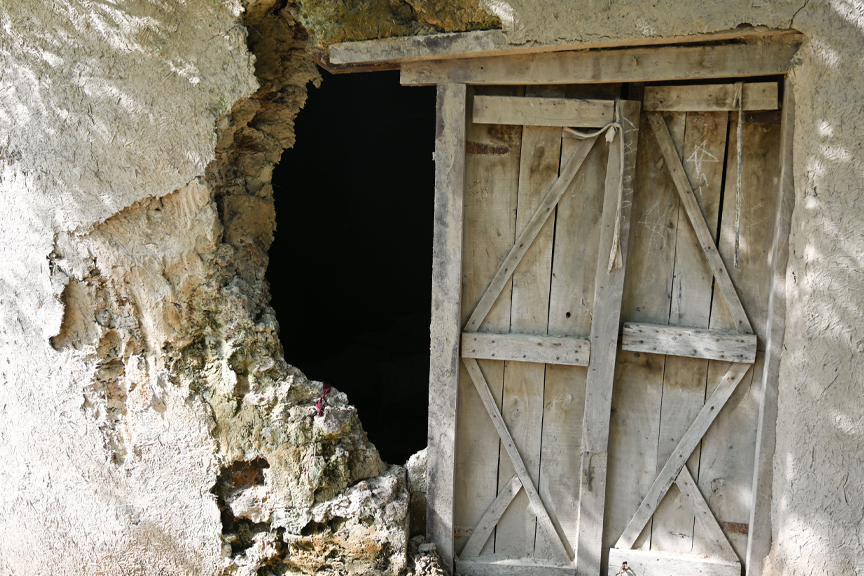
Beyond Despair
Last week Michael Barnett, University Professor of International Affairs and Political Science, and Maryam Z. Deloffre, Associate Professor of International Affairs and Director, Humanitarian Action Initiative, co-hosted, with Community World Service Asia (CWSA), a half-day conference, “Beyond Despair,” at the Regional Humanitarian Partnership Week (RHPW) meetings in Bangkok, Thailand. The RHPW is organized by Asian Disaster Reduction & Response Network (ADRRN), CWSA, the International Council of Voluntary Agencies (ICVA) and the United Nations Office for the Coordination of Humanitarian Affairs (UNOCHA) and is the largest gathering of humanitarian actors in the region. In Beyond Despair, Barnett and Deloffre focused on the positive–how do humanitarian actors leverage their creativity and pragmatism to provide aid despite access challenges and structural barriers? Professor Barnett presented data from a survey conducted last year with Smruti Patel of Global Mentoring Initiative (GMI) and Political Science Ph.D. student Alex Vandermaas-Peeler, on the nature and sources of structural barriers – racism/colonialism embedded in attitudes and institutions, funding (and lack thereof), access constraints etc. Professor Deloffre then led a discussion on how humanitarian actors bypass these barriers to provide life-saving assistance. Over 250 practitioners, policymakers and academics from Asia, the Middle East and Africa attended the session.
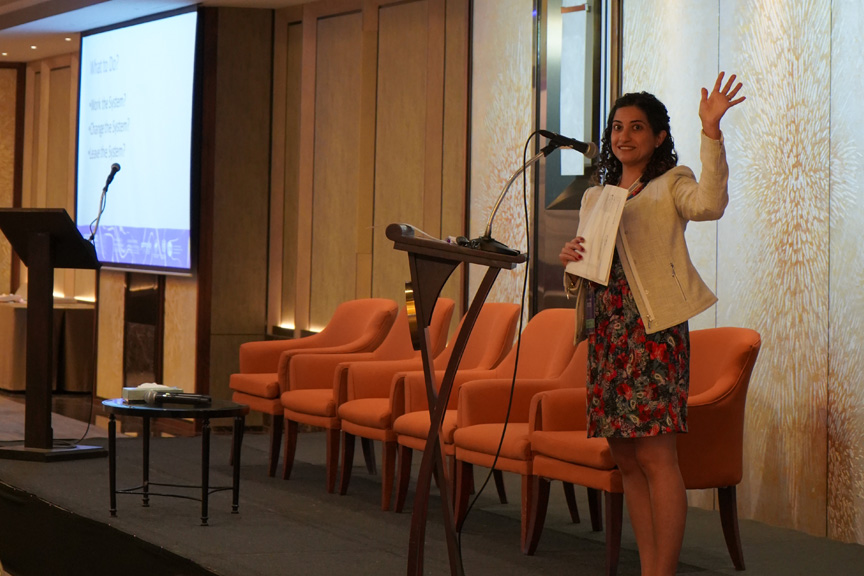
The idea for Beyond Despair, is rooted in both Barnett and Deloffre’s ongoing research on localization, a policy initiative to reform the global humanitarian system by empowering local communities and populations affected by disasters to lead humanitarian action. Professor Deloffre teaches a graduate level course on the topic, IAFF 6138 Localizing Humanitarian Action, which is offered in the spring. Barnett and Deloffre collected narrative data at the workshop and will share findings with meeting participants as well as in future publications.
The second half of the Beyond Despair conference featured a panel discussion on Survival Strategies, how national and local humanitarian groups innovate and partner effectively to provide humanitarian assistance. Panelists included: Juliet Parker, director of Active Learning Network for Accountability and Performance in Humanitarian Action (ALNAP), who discussed the positive news from the recent State of the Humanitarian System report; Smruti Patel, founder of GMI, who described local and regional certification schemes; Nannette Antequisa, Executive Director, Ecosystems Work for Essential Benefits (ECOWEB), Philippines, who detailed empowering partnership models; Takeshi Komino, Vice President of ADRRN, who discussed private-public partnership models, and Sudhanshu S. Singh, Founder and Director, Humanitarian Aid International, who highlighted his NGO’s survival strategies. Dr. Hanna A. Ruszczyk, Department of Geography, Durham University, served as the moderator.
Training On Strengthening Organisations through Introducing Core Humanitarian Standard and Quality and Accountability Mainstreaming
When: 19th-21st, December 2022 (arrival at venue on 18th Dec 2022)
Where: Umerkot, Sindh
Language: Urdu and English
Interested Applicants: Click here to register
Last Date to Apply: 5th-Dec-2022 (incomplete applications will not be entertained)
Training Objectives: Through this training, you will be able to:
- Identify the key Q&A initiatives and their tools to support Project Cycle Management
- Select and adapt existing Q&A tools and resources to overcome challenges throughout the Project Cycle
- Outline the opportunities and challenges faced by humanitarian workers in implementing Q&A approaches and tools throughout the project cycle
- Identify means by which you and your colleagues can collaborate and coordinate with other agencies to improve the quality and accountability of a humanitarian response
- Introducing and mainstreaming quality and accountability mechanisms through the organisation
Training Purpose
The impact of humanitarian work on communities depends greatly upon the quality of services and accountability of actions both during emergency and non-emergency times. With millions of people affected by disasters and conflicts, the importance of Quality & Accountability (Q&A) is undeniable. The effective implementation of Core Humanitarian Standard on Quality and Accountability (CHS) requires a commitment to build institutional and individual capacity of people engaged in designing and implementing humanitarian as well as development projects.
Community World Service Asia (CWSA) aims to ensure that all relevant agencies including NGOs, INGOs, UN, donors, universities and government agencies, playing an active role in the disaster response & rehabilitation are given the opportunity to implement Quality and Accountability approaches and tools in their work.
Number of Participants
- 20-25 participants will be selected for the training. Women and staff belonging to ethnic/religious minorities are encouraged to apply.
- Preference will be given to participants representing organizations working in Umerkot and surroundings.
Selection Criteria
- You have experience in managing a key position
- You have an idea about the Q&A initiatives
- You are interested in introducing Q&A mechanisms in your organisation
- You have a ‘good enough’ command of English.
Fee Details
- Training fee for each participant is PKR 10,000. Fee concessions and scholarships are available for participants belonging to marginalised groups and NGOs with limited funding.
- No TA/DA will be given to participants and travel expenses will be incurred by participants themselves.
Community World Service Asia (CWSA) is a humanitarian and development organization, registered in Pakistan, headquartered in Karachi and implementing initiatives throughout Asia. CWSA is member of the Core Humanitarian Standard (CHS) Alliance, a member of Sphere and their regional partner in Asia and also manages the ADRRN Quality & Accountability Hub in Asia.
Beyond Despair
Date and time
Friday, December 9, 2022, 9:30 AM – 12:00 PM Thailand Time
Location
Rembrandt Hotel & Suites Bangkok
We know the bad news of structural constraints in the sector, but what about the successes? This conference features reflections on how we deliver aid despite the obstacles.
Join us at the ‘Beyond Despair’ Regional Humanitarian conference marking the launch of the annual Regional Humanitarian Partnership Week 2002 (RHPW) in Bangkok this December.
Reserve your spot here: https://www.eventbrite.com/e/beyond-despair-tickets-453931410067

